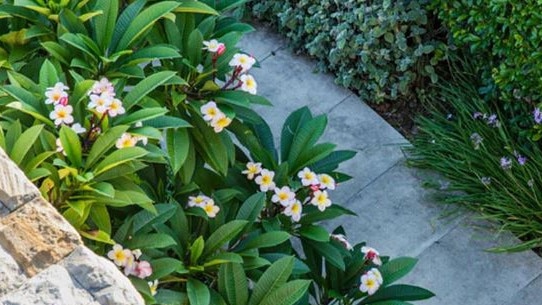How to grow frangipanis from a cutting
Go ahead and take a cutting. But don’t forget your manners. Ask permission before you prune these summertime beauties. Our expert Helen Young will help with the rest.

Frangipani trees hit their peak at this time of year, their flowers a symbol of summer and holidays. They’re the ideal small tree to grow against the north or west side of a house, providing summer shade but letting the winter sun shine through, without risk of roots damaging the foundations. The classic colour is white with a yellow centre but worldwide there are thousands of different colours from pure whites to yellow, peach and apricot shades, pinks and deep reds. There are tricolours in sunset tones, and some flowers change colour as they age; more recent varieties are lilac and lavender. Their fragrance varies too, between varieties and according to the time of day.
Frangipanis (botanically Plumeria) are expensive because they’re slow-growing, but they grow easily from cuttings, even branches 2m-3m long. You can take cuttings any time, but ideally do it in late winter before the sap starts to flow. Let them dry in shade for a few weeks to form callus tissue, from which new roots will grow. To avoid rotting, plant into sandy propagating mix and only water when it dries out. Always ask permission if you want a piece of a tree whose colour you admire.
Four of a kind
Frangipanis do best with plenty of sun in warm to hot climates; in cooler areas they need a warm, protected microclimate.


They tolerate drought, salt, coastal exposure, tropical drenchings and light frosts. They even do well in pots, but hate wet feet.


Q&A
The Eumundi quandongs we planted along our fence three years ago for privacy have grown quickly, but the lower foliage is disappearing. How can we encourage growth all over?
Elizabeth Moulton, by email
As trees grow taller, loss of the lowest (and earliest) branches is normal. It’s worse when the lower parts are shaded by fences or the upper growth. You can counter this somewhat by regularly pruning the tops, which stimulates side shoots and helps limit overshadowing. Once the lowest branches die off it’s almost impossible to make trees replace them.
Inspired by travels in Japan, we’d like to start a bonsai. What are the best species for unskilled people to start with?
Gloria Dubcek, Perth
Bonsai is a skilled art, so I’d suggest you do an introductory course, either in person or online. Some of the easiest to learn with are Port Jackson and Moreton Bay figs, junipers, Chinese elm (Ulmus parvifolia), trident maple, (Acer buergerianum) and olives. You might find small, self-seeded plants of the last three that you can dig up. You can also try jade plant and native banksias, melaleucas and casuarinas.
Our front lawn is looking very motley, despite TLC, rain and warmth. At the top of the slope, it’s more brown than green. What can we do?
Helen Mahoney, Brisbane
If the soil is compacted, turf will always struggle to grow. You can de-compact it with a garden fork, spike roller or corer. Ensure the soil pH is between 6 and 7. Apply a hose-on wetting agent. Check for curl grubs that eat lawn roots by placing a wet towel or hessian on a patch overnight; they’ll cluster under it by morning. Or pour on soapy water to force them to the surface. Large bare patches might need to be re-turfed.
Send your questions to helenyoungtwig@gmail.com. The best question for December/January wins Paul Bangay’s latest book A Life in Garden Design (Thames and Hudson, $80).





To join the conversation, please log in. Don't have an account? Register
Join the conversation, you are commenting as Logout